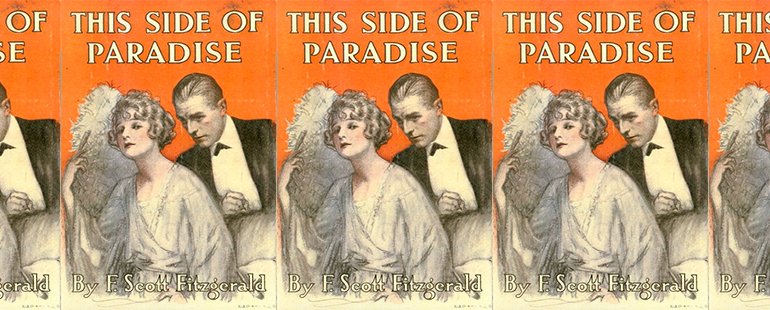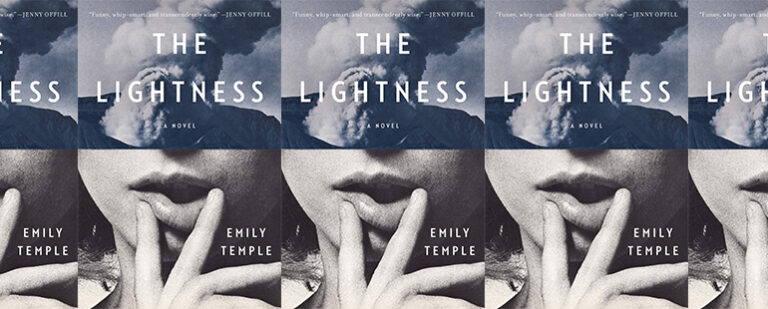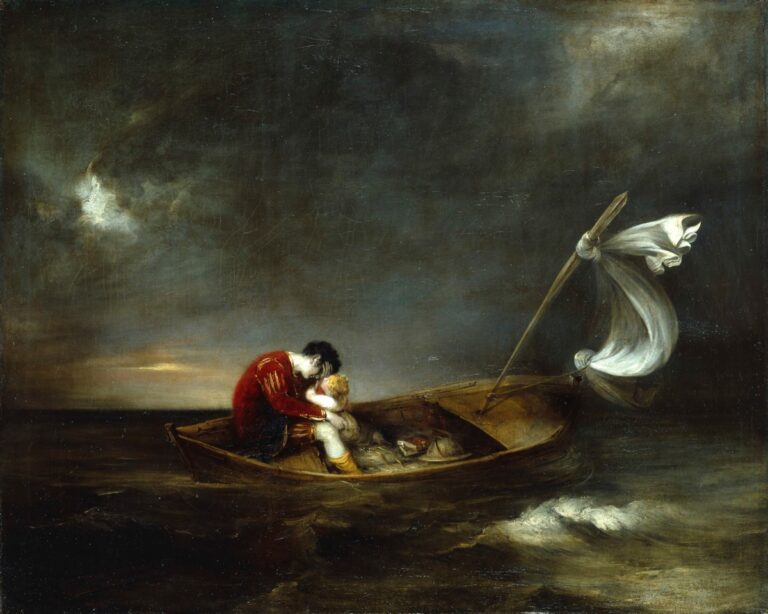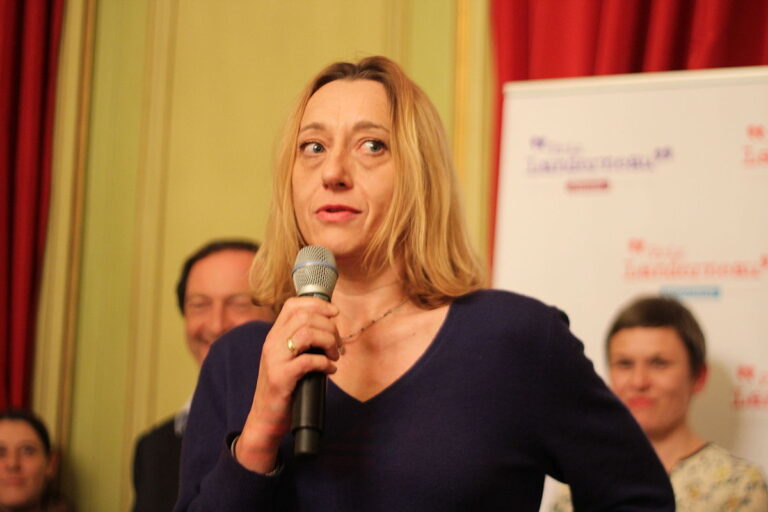One Hundred Years Later: The Dark Predictions in This Side of Paradise Have All Come True

This Side of Paradise—the debut novel by F. Scott Fitzgerald—turns one hundred today. First published on March 26 in 1920, the novel sold out its initial printing in less than a week. The New York Times called it “nearly perfect” and H.L. Mencken, in The Smart Set, said it was “a truly amazing first novel.” Perhaps accelerating the novel’s popularity among college-aged readers, the president of Princeton University at the time, John Grier Hibben, publicly denounced the work and said that he could not “bear to think that our young men are merely living four years in a country club and spending their lives wholly in a spirit of calculation and snobbishness.” Indeed, Hibben’s response echoed the widespread critical sentiment that the novel was a shocking and powerful depiction of a new generation, maligned and misunderstood; that very same emphasis on the book’s socio-cultural portraiture, however, may have allowed subsequent generations of critics to echo its relevance in merely documenting the 1920s American zeitgeist, surviving as no more than an artifact, while overlooking the novel’s enduring artistic achievements.
One hundred years later, the popular legend of F. Scott Fitzgerald’s life complicates a critical reappraisal of his debut novel: we can either read This Side of Paradise via the historical lens of Fitzgerald’s biography and treat the novel as a roman a clef—that’s the well-trodden path, Amory Blaine as F. Scott, Rosalind as Zelda Sayre—or we can follow the dictum of T.S. Eliot, later advocated by Roland Barthes, and divest our knowledge of Fitzgerald’s life—proceed as if we know nothing about it—and examine the text on its own, putting our faith in poet-critic Stephane Mallarme’s maxim: “it is the language that speaks.” This latter reading, treating the text as hermetically self-contained, leads to some surprising and interesting results that bear direct relevance on a new generation of young American readers today.
This Side of Paradise employs the narrative procedure of a Künstlerroman—a subset of the bildungsroman that charts the emotional development of an artist or an intellectual. Charlotte Brontë’s Jane Eyre and Ralph Ellison’s Invisible Man are two comparable examples of how this form works. The first half of This Side of Paradise explores Amory’s years at Princeton; the second half of the book explores his sexual awakening as a young adult and his rejection of the capitalist industrial complex as a measure of his personal self-worth.
We don’t need to know anything about Fitzgerald’s experience at Princeton—or even whether he went to college at all—to explore the novel’s intimate portrait of “a breathless social system,” digressing into the nuances of dining clubs and all the other “social barriers as artificial distinctions made by the strong to bolster up their weak retainers and keep out the almost strong.” The novel creates and communicates a subtle world full of “brilliant adventurers and well-dressed philanderers,” and makes the distinction that “writing for the Nassau Literary Magazine would get [Amory] nothing but that being on the board of the Daily Princetonian would get any one a good deal.” The details spring from Amory’s ambition and his relatable anxiety that as a college freshman the other “men turn to look at him critically” and he wonders “if there was something wrong with his clothes.”
The specifics in the novel color this particular social milieu and make it inhabitable for the modern reader, while the more universal emotions of fear, loneliness, and ambition transport the story beyond Princeton for a wider readership that may know nothing about Nassau Street and its environs. The book’s inadequate exploration of race, however, may limit its connection with some contemporary readers; Princeton did not admit its first students of color until the 1940s. Elsewhere in US fiction, Ralph Ellison later achieves—and evolves—this idiosyncratic collegiate world-making in his fictionalized account of the Tuskegee Institute in Invisible Man. Ellison accomplishes everything that Fitzgerald had done in This Side of Paradise but takes it much further in exploring how race informs the quest for identity and knowledge of self. Indeed, the two books share many interesting similarities: they are debut novels, they are each a Künstlerroman, they explore university life, their protagonists move to New York City, and they both ultimately reject the conventions of the capitalist industrial complex. One of the principal differences between the two books may be Ellison’s humor: Invisible Man is a very funny novel, with critics exploring how comedy works within its narrative structure, while the tone of Paradise remains serious, studious.
Still, both works serve to frame the evolution of the “college novel” from the beginning of the twentieth century to the post-World War II era, to the onset of the end of the twentieth century, when the college-application industry exploded with digital technologies like the online Common Application. Even as Princeton remained open only to white men in Fitzgerald’s era, the past century has coincided with a revolutionary change in the role college plays in the lives of US teenagers—expanding beyond the realm of wealthy men to a more representative population of US youth. Where Amory’s mother Beatrice quaintly says “we’ll let the university question take care of itself,” we see headlines in the newspapers today about bribery, fraud, and Federal investigations, all referring to teenagers applying to and fighting to get into college.
After returning from World War I, Amory grows up: he moves to New York City, splits an apartment with his college roommate, gets a job writing copy, and falls in love with “the only girl in the wide world that could have held [him].” In other words, he establishes an archetype for subsequent generations of young artistic men who dream of something greater. There in New York, however, we see all the dreams from Amory’s youthful days at Princeton dashed: his friends have died in the war; his parents, too, are now dead; his mentor is dead; his wealth has evaporated; and his new job only pays him “thirty-five dollars a week—less than a good carpenter.” Amory’s experience, more than a hundred years earlier, reads with uncanny relevance to the phenomenon of millions of young millennials who have graduated from college and moved to New York City or other too-expensive cosmopolitan cities, only to fall back onto their parents’ couch.
This experience feels far more recognizable and relevant today than the decadent expatriate romance in Tender is the Night; likewise, the bootlegging extravagance of Jay Gatsby and gangster-isms of Meyer Wolfsheim seem like caricatures, cartoonish in comparison to the complex characterization of Amory Blaine who, as a “good man going wrong,” allows people to “stand around and literally warm themselves at the calories of virtue he gives off.” Amory’s precipitous decline calls to mind the moral descent of Oscar Wilde’s Dorian Gray, Goethe’s Faust, or even, looking further back, Dante’s opening gambit—“Nel mezzo del cammin di nostra vita”—in The Divine Comedy, a comparison which bears consideration if only for Fitzgerald’s choice in naming Amory’s mother after Beatrice, Dante’s ideal of celestial beauty.
Amory’s rejection of capitalism also connects This Side of Paradise with two interesting issues still widely discussed: socialism and the free press. He quits his advertising job because “it didn’t matter a damn to [him] whether Harebell’s flour was any better than anyone else’s.” But, more accurately, Amory quits because his job will never bring him the wealth he needs to marry Rosalind, who dreads responsibility and does “not want to think about pots and kitchens and brooms.” His failed relationship with her sparks the subsequent realization that without money, he lacks agency and power. He descends into nascent alcoholism, then voices his new disillusionment with the economic and political realities of his situation: “We want to believe,” he tells his roommate Tom, by way of explaining how his views have evolved. “Young students try to believe in older authors, constituents try to believe in their Congressmen, countries try to believe in their statesmen, but they can’t.” And, then, in a passage that reads eerily similar to a 2020 New York Times op-ed piece on US politics, Amory explains that there are “too many voices, too much scattered, illogical, ill-considered criticism. It’s worse in the case of the newspapers. Any rich, unprogressive old party with that particularly grasping, acquisitive form of mentality known as financial genius can own a paper that is the intellectual meat and drink of thousands of tired, hurried men.” One must look no further than Fox News to see the continued power of Amory’s realization about the double-helix of wealth and power in the US media. He concludes his powerful evocate tired, by judging that “for two cents, the voter buys his politics, prejudices, and philosophy.”
Amory returns to Princeton in the book’s final sequence. He hitchhikes all the way to New Jersey and accepts a ride from a polished, wealthy-looking car; inside, he meets two older gentlemen, one of which had a son at Princeton the same age as Amory. As they talk, Amory complains about his financial situation to the older man and says: “Being very poor at present I am contemplating socialism as possibly my forte.” This marks an interesting revelation in Amory’s interiority: he has been broken by New York, and cheated by his own expectations of a wealthy life with Rosalind that his inheritance would have afforded him, had it not dried up. This is where some critics might dive into Fitzgerald’s personal letters to Zelda Sayre and try to employ a biographical reading of the text based on Fitzgerald’s own vacillating wealth, attempting to assert whether F. Scott shared Amory’s rejection of capitalism; the text itself, however, charts its own compelling ambivalence about the pursuit of money, as Amory works through and processes his own fate and experience within the text. He debates the issue of economics in the car ride back to Princeton and concludes that “socialism may not be progress, but the threat of the red flag is certainly the inspiring force of all reform. You’ve got to be sensational to get attention.” Scoffing, the older man—characterized as “goggle-eyed”—rejects Amory’s thinking and retorts that “government ownership is the whole basis of [Amory’s] argument, and it’s invariably a beehive of corruption. Men won’t work for blue ribbons, that’s all rot.” Amory concedes that he “wasn’t sure of half of what [he] said,” but that he had every reason to throw his “mind and pen in with the radicals.” The conviction in his character raises the question about what sort of work Fitzgerald might have written if he hadn’t gotten rich and married (critic William J. Quirk estimated that This Side of Paradise put Fitzgerald in the top 2 percent of earners in the US), and if he had remained loyal to Amory’s own maxim that “Money isn’t the only stimulus that brings out the best that’s in a man, even in America.” That final clause—even in America—echoes darkly today. The return to Princeton is a return to a “faint stirring of old ambitions and unrealized dreams,” but Amory stops short of the towers and spires and hears in “the clear darkness the sound of bells.”
This Side of Paradise opens with promise; it closes like a warning. And one hundred years later, the omens of disillusion and discontent, of economic unease, of rebellious divisions—they all seem more urgent and more dangerous with every re-reading. The character of Amory Blaine, at once an egotist and, later, a personage, should still resonate with a new generation of readers: his romance, obsessions, dreams, and failure all still carry the momentum and emotional climax necessary for great literature to endure. This book knows itself—and still stands on its own.


